Abstract
The expression of the CD11b antigen and the presence of the S-100 (and, specifically, its beta subunit) protein within the T4- subpopulation of normal human peripheral blood lymphocytes were investigated by panning techniques, immunofluorescence analysis and immunoelectronmicroscopy. Both antigens are known to be absent in the T4+ lymphocytes. However, CD11b+ T lymphocytes represented about 30% of the T4- population; a part of them (over 1/3) belonged to and completely filled up the T4- T8- subpopulation, whereas the remaining part (almost 2/3) shared the T8 positivity. Interestingly, S-100+ T lymphocytes, which always were CD11b+ too, represented about one half of the CD11b+ T cells, but were excluded from the T4- T8- CD11b+ subpopulation, whereas they represented up to 80% of the T4- T8+ CD11b+ subset. Such findings demonstrate that the S-100+ T lymphocytes are exclusively restricted to a discrete T cell compartment which shows the T8+ CD11b+ immunophenotype. Since such T8+ CD11b+ cells had been shown to possess suppressive capabilities, we herein propose that S-100+ lymphocytes might to some extent modulate the immune responses. However, the exact functional significance of the S-100 protein still remains unknown.
Full text
PDF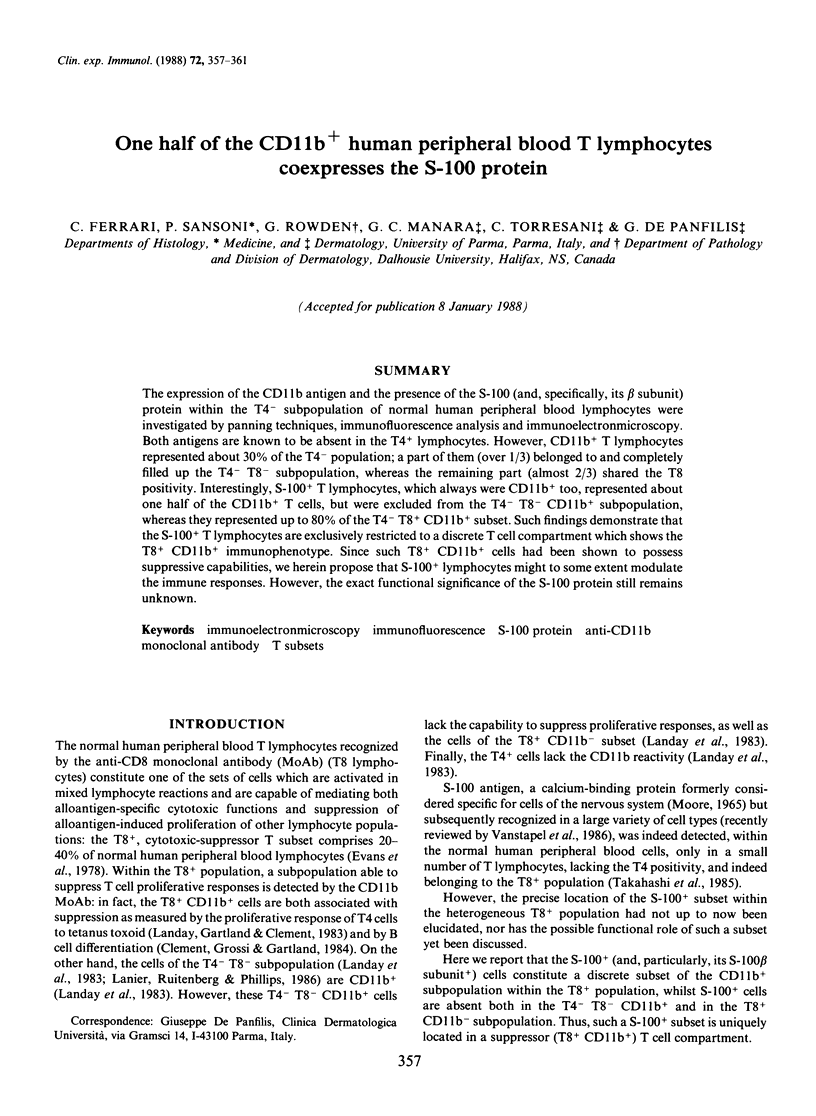
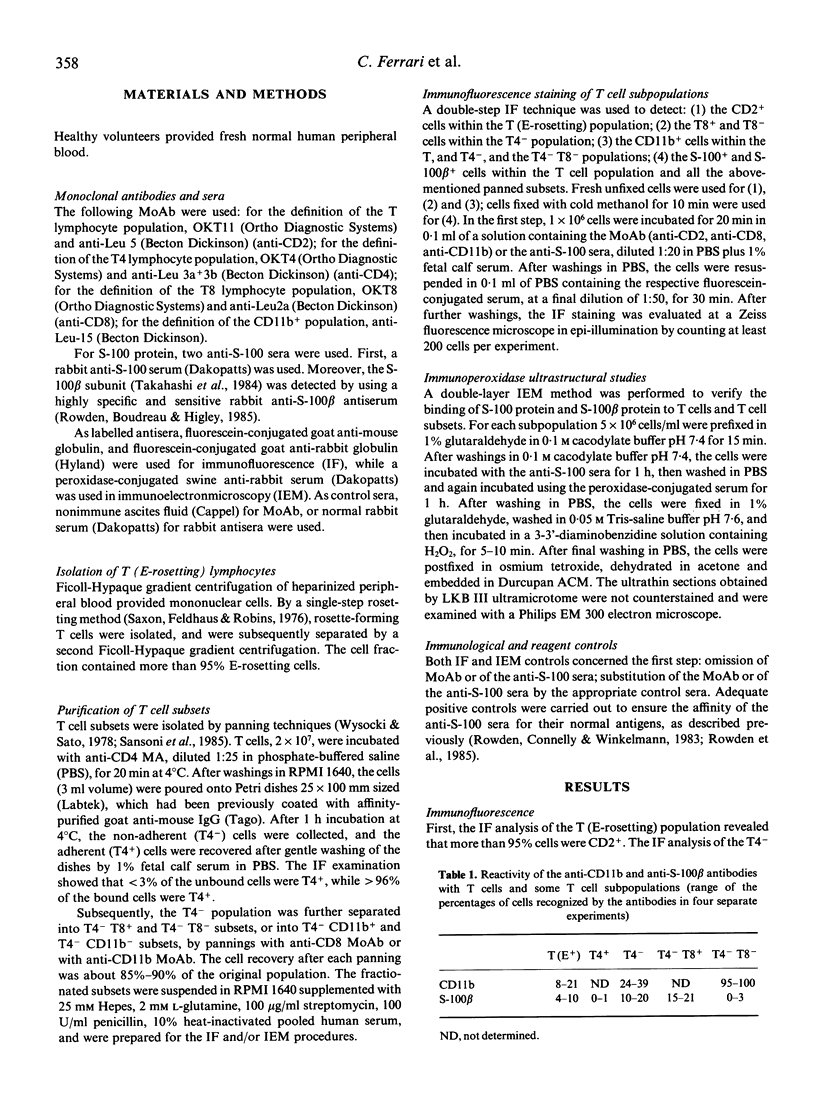
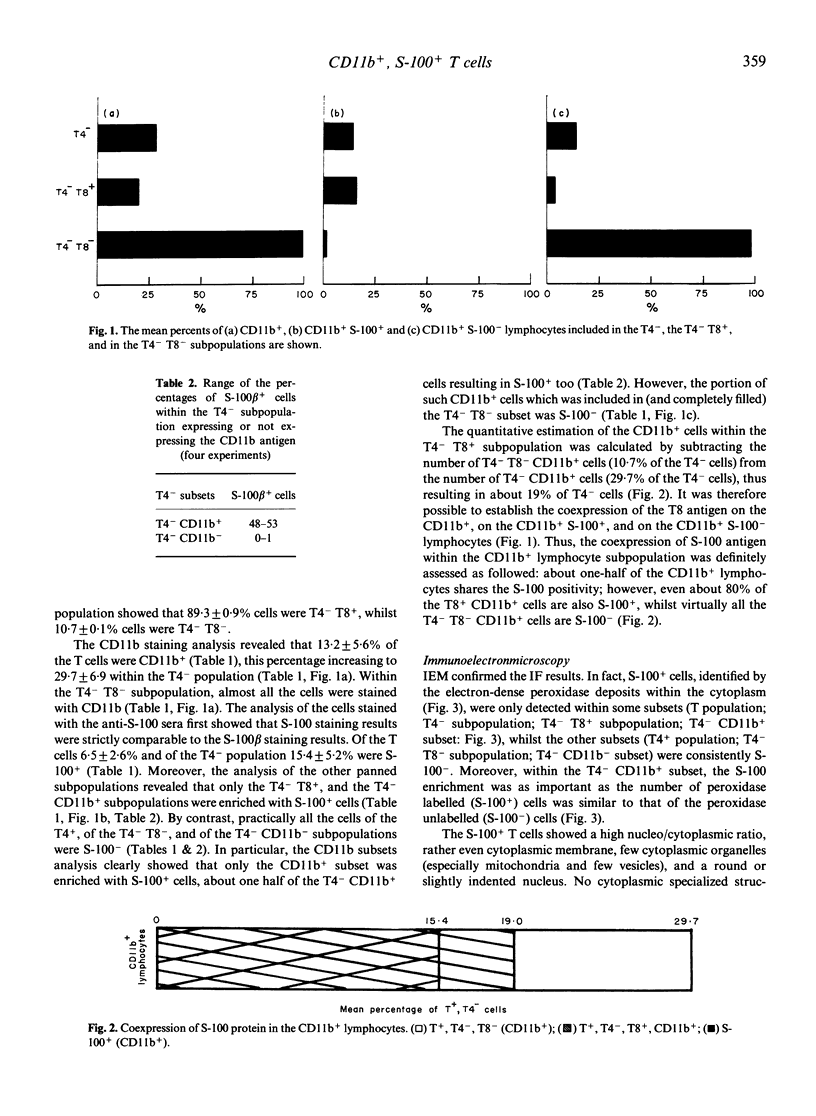
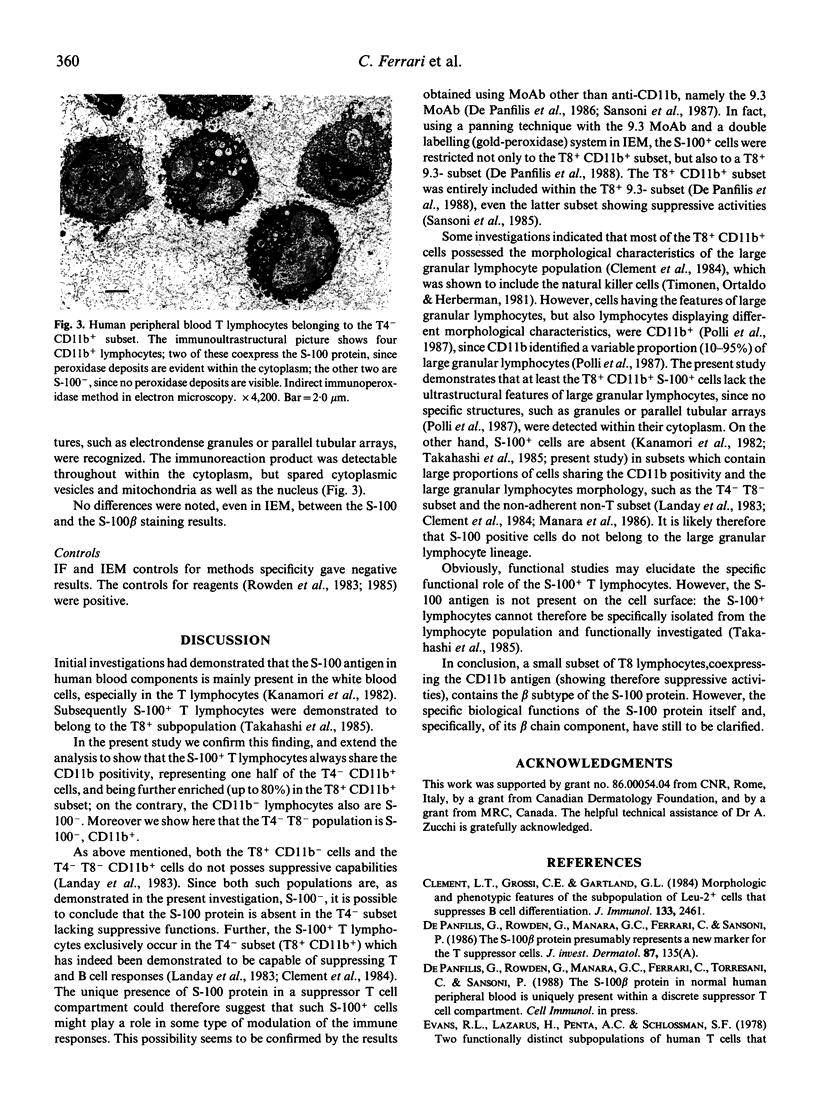
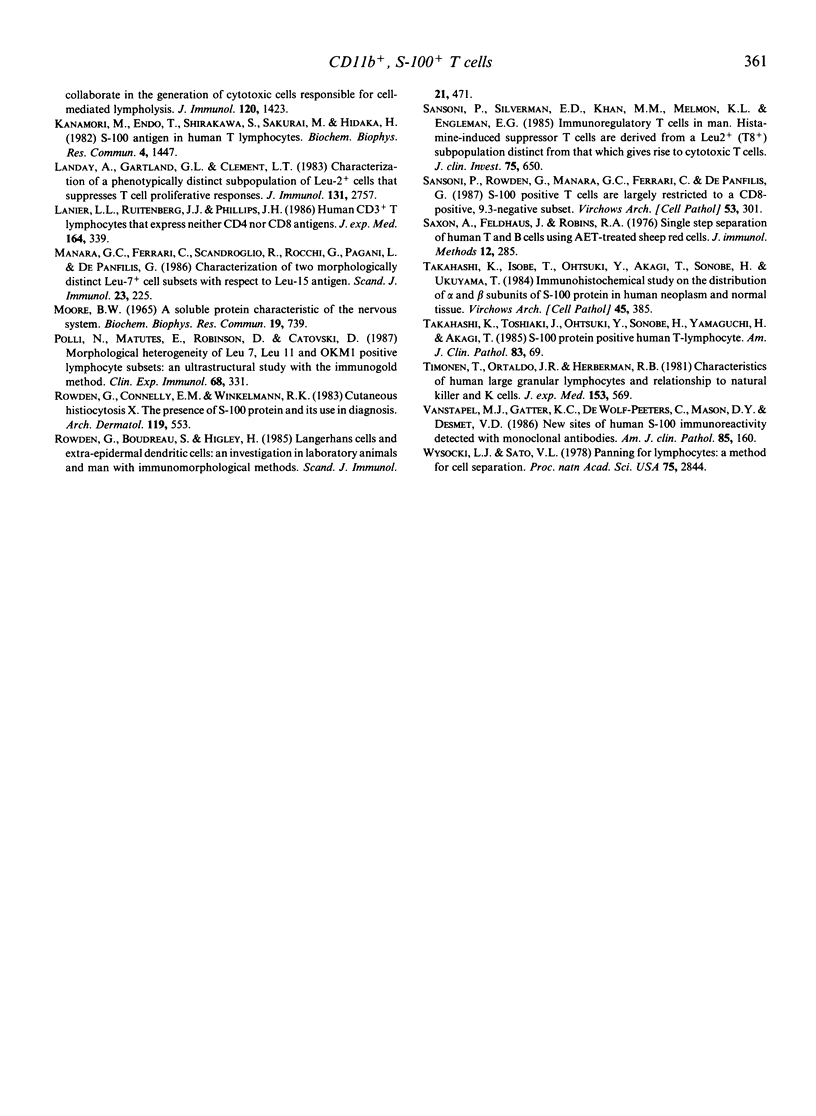
Images in this article
Selected References
These references are in PubMed. This may not be the complete list of references from this article.
- Clement L. T., Grossi C. E., Gartland G. L. Morphologic and phenotypic features of the subpopulation of Leu-2+ cells that suppresses B cell differentiation. J Immunol. 1984 Nov;133(5):2461–2468. [PubMed] [Google Scholar]
- Evans R. L., Lazarus H., Penta A. C., Schlossman S. F. Two functionally distinct subpopulations of human T cells that collaborate in the generation of cytotoxic cells responsible for cell-mediated lympholysis. J Immunol. 1978 Apr;120(4):1423–1428. [PubMed] [Google Scholar]
- Kanamori M., Endo T., Shirakawa S., Sakurai M., Hidaka H. S-100 antigen in human T lymphocytes. Biochem Biophys Res Commun. 1982 Oct 29;108(4):1447–1453. doi: 10.1016/s0006-291x(82)80069-7. [DOI] [PubMed] [Google Scholar]
- Landay A., Gartland G. L., Clement L. T. Characterization of a phenotypically distinct subpopulation of Leu-2+ cells that suppresses T cell proliferative responses. J Immunol. 1983 Dec;131(6):2757–2761. [PubMed] [Google Scholar]
- Lanier L. L., Ruitenberg J. J., Phillips J. H. Human CD3+ T lymphocytes that express neither CD4 nor CD8 antigens. J Exp Med. 1986 Jul 1;164(1):339–344. doi: 10.1084/jem.164.1.339. [DOI] [PMC free article] [PubMed] [Google Scholar]
- Manara G. C., Ferrari C., Scandroglio R., Rocchi G., Pagani L., De Panfilis G. Characterization of two morphologically distinct Leu-7+ cell subsets with respect to Leu-15 antigen. Evaluation of Leu-15 determinant distribution on both E rosetting and non-adherent non-E rosetting cell populations. Scand J Immunol. 1986 Feb;23(2):225–231. doi: 10.1111/j.1365-3083.1986.tb01961.x. [DOI] [PubMed] [Google Scholar]
- Moore B. W. A soluble protein characteristic of the nervous system. Biochem Biophys Res Commun. 1965 Jun 9;19(6):739–744. doi: 10.1016/0006-291x(65)90320-7. [DOI] [PubMed] [Google Scholar]
- Polli N., Matutes E., Robinson D., Catovsky D. Morphological heterogeneity of Leu7, Leu11 and OKM1 positive lymphocyte subsets: an ultrastructural study with the immunogold method. Clin Exp Immunol. 1987 May;68(2):331–339. [PMC free article] [PubMed] [Google Scholar]
- Rowden G., Boudreau S., Higley H. Langerhans cells and extra-epidermal dendritic cells. An investigation in laboratory animals and man with immunomorphological methods. Scand J Immunol. 1985 May;21(5):471–478. doi: 10.1111/j.1365-3083.1985.tb01834.x. [DOI] [PubMed] [Google Scholar]
- Rowden G., Connelly E. M., Winkelmann R. K. Cutaneous histiocytosis X. The presence of S-100 protein and its use in diagnosis. Arch Dermatol. 1983 Jul;119(7):553–559. doi: 10.1001/archderm.119.7.553. [DOI] [PubMed] [Google Scholar]
- Sansoni P., Rowden G., Manara G. C., Ferrari C., De Panfilis G. S-100-positive T cells are largely restricted to a CD8-positive, 9.3-negative subset. Virchows Arch B Cell Pathol Incl Mol Pathol. 1987;53(5):301–307. doi: 10.1007/BF02890256. [DOI] [PubMed] [Google Scholar]
- Sansoni P., Silverman E. D., Khan M. M., Melmon K. L., Engleman E. G. Immunoregulatory T cells in man. Histamine-induced suppressor T cells are derived from a Leu 2+ (T8+) subpopulation distinct from that which gives rise to cytotoxic T cells. J Clin Invest. 1985 Feb;75(2):650–656. doi: 10.1172/JCI111743. [DOI] [PMC free article] [PubMed] [Google Scholar]
- Saxon A., Feldhaus J., Robins R. A. Single step separation of human T and B cells using AET treated srbc rosettes. J Immunol Methods. 1976;12(3-4):285–288. doi: 10.1016/0022-1759(76)90050-8. [DOI] [PubMed] [Google Scholar]
- Takahashi K., Isobe T., Ohtsuki Y., Akagi T., Sonobe H., Okuyama T. Immunohistochemical study on the distribution of alpha and beta subunits of S-100 protein in human neoplasm and normal tissues. Virchows Arch B Cell Pathol Incl Mol Pathol. 1984;45(4):385–396. doi: 10.1007/BF02889881. [DOI] [PubMed] [Google Scholar]
- Takahashi K., Isobe T., Ohtsuki Y., Sonobe H., Yamaguchi H., Akagi T. S-100 protein positive human T-lymphocyte. Am J Clin Pathol. 1985 Jan;83(1):69–72. doi: 10.1093/ajcp/83.1.69. [DOI] [PubMed] [Google Scholar]
- Timonen T., Ortaldo J. R., Herberman R. B. Characteristics of human large granular lymphocytes and relationship to natural killer and K cells. J Exp Med. 1981 Mar 1;153(3):569–582. doi: 10.1084/jem.153.3.569. [DOI] [PMC free article] [PubMed] [Google Scholar]
- Vanstapel M. J., Gatter K. C., de Wolf-Peeters C., Mason D. Y., Desmet V. D. New sites of human S-100 immunoreactivity detected with monoclonal antibodies. Am J Clin Pathol. 1986 Feb;85(2):160–168. doi: 10.1093/ajcp/85.2.160. [DOI] [PubMed] [Google Scholar]
- Wysocki L. J., Sato V. L. "Panning" for lymphocytes: a method for cell selection. Proc Natl Acad Sci U S A. 1978 Jun;75(6):2844–2848. doi: 10.1073/pnas.75.6.2844. [DOI] [PMC free article] [PubMed] [Google Scholar]



